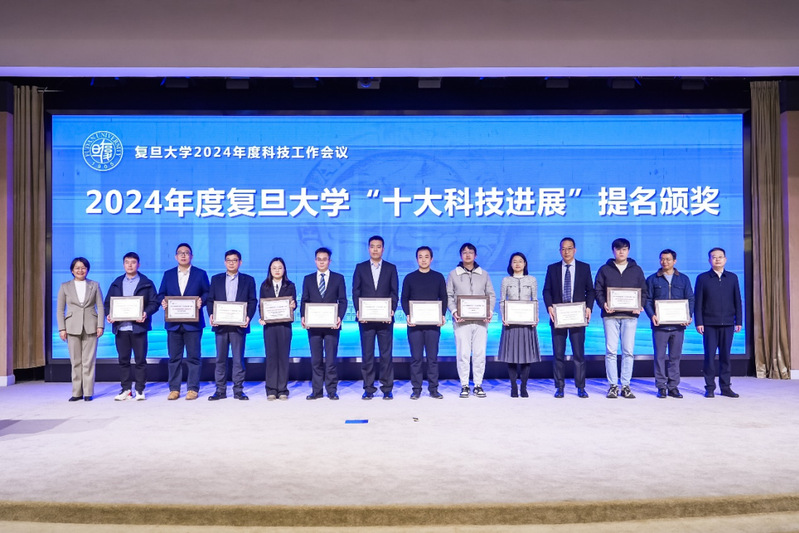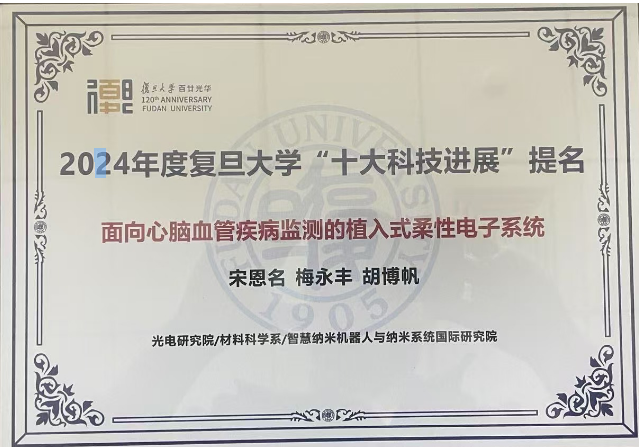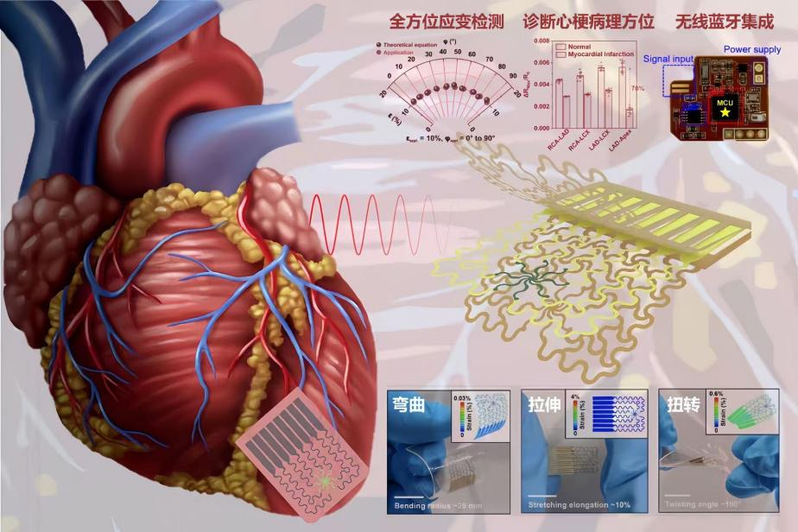2025年1月7日上午,2024年度复旦大学“十大科技进展”评选结果揭晓。我院梅永丰教授、宋恩名青年研究员团队的成果“面向心脑血管疾病监测的植入式柔性电子系统”获2024年度复旦大学“十大科技进展”提名奖。

复旦大学“十大科技进展”评选活动始于2022年,旨在凝心聚力建设“第一个复旦”,深入推进科技评价的改革,表彰激励科研团队原始创新的精神,宣传展示学校科技工作的突破,推动营造良好的科技创新氛围,至今已举办三届。

如何能在动态变形的器官表面上进行高分辨率、多方向的应变监测,是复杂心脑血管疾病诊断领域的前沿科学问题。我院研究团队提出了一种基于单晶硅纳米薄膜阵列的植入式可降解应变传感器,可实现高灵敏度、全轴向360°的应力应变探测,成功在大鼠模型上实现了心肌梗塞病理监测,长期植入后该器件可体内自降解,为复杂软组织生物力学的持续监测提供了新型临床应用技术方案。相关成果于2024年发表在Science Advances和PNAS杂志上。该成果以医工交叉新思路克服植入式柔性电子系统监测复杂心脑血管疾病的技术难题,为复杂心脑血管疾病的在体监测提供医工交叉新思路,为未来人机交互的柔性电子系统奠定研究基础。

Undergraduate Student Supervised by Prof. Jizhai Cui at IIINN Honored with Fudan University’s Annual “Outstanding Student Model” Title
The selection results of the 2024 Fudan University Top Ten Scientific and Technological Advances were announced on January 7th, 2025. The research team led by Prof. Yongfeng Mei and Prof. Enming Song from our institute won the nomination award for the 2024 “Top Ten Scientfic and Technological Advances” at Fudan University for their achievement Implantable Flexible Electronic System for Monitoring Cardiovascular and Cerebrovascular Diseases.
The selection of Top Ten Scientific and Technological Advancements at Fudan University, initiated in 2022, aims to unite efforts in building the first Fudan, to deepen the reform of scientific and technological evaluation, to commend and motivate the spirit of original innovation among scientific research teams, to publicize and showcase the breakthroughs in the university's scientific and technological work, and to foster a positive atmosphere for scientific and technological innovation. Three eitions have been held so far.
How to perform high-resolution and multi-directional strain monitoring on dynamically deformed organ surfaces is a cutting-edge scientific problem in the diagnosis of complex cardiovascular and cerebrovascular diseases. Our research team has proposed an implantable degradable strain sensor based on a single crystal silicon nanomembrane array, which can achieve high sensitivity and full axis 360 ° stress-strain detection. It has successfully achieved pathological monitoring of myocardial infarction in a rat model. After long-term implantation, the device can self degrade in vivo, providing a new clinical application solution for continuous monitoring of complex soft tissue biomechanics. The relevant results were published in the journals Science Advances and PNAS in 2024. This achievement overcomes the technical challenges of using implantable flexible electronic systems to monitor complex cardiovascular and cerebrovascular diseases with a new approach of medical engineering intersection, providing new ideas for monitoring in vivo of complex cardiovascular and cerebrovascular diseases and laying a research foundation for future human-machine interactive flexible electronic systems.
撰稿:程绍平
校稿:陈茜
审核:黄高山
